
32 minute read
Mental Fitness
WHAT DOES IT MEAN TO BE MENTALLY FIT?
In the same way there are processes and training available to help avoid physical injuries in the workplace, mental health and its associated symptoms require the same level of attention. With workers in construction and trades like welding and fabrication at an increased risk of mental illness, employers and employees alike are encouraged to work together towards positive mental health habits.
Advertisement
Suicide is the leading cause of death for Australians between 15 and 44 years of age, and men are three times more likely to die by suicide than women. Workers in construction and other trades—including welding—are even more at risk. Tradies are 70% more likely to die by suicide than their behind-the-desk counterparts. This means that every second day an Australian tradie takes their own life.
Despite these alarming statistics, mental health definitely isn’t something that tradies talk about at smoko or after knocking off. But this trajectory can change, with a focus on improving mental fitness.
What is Mental Fitness and How Does it Help? Mental fitness involves a state of wellbeing and awareness around how people think, act and feel about their daily lives. Mental fitness is about training the brain to deal with daily stresses without feeling overwhelmed, upset or worried.
This unlocks a balance between personal and professional choices. For example, when an employee is mentally fit, they recognise workplace stresses and use time and space to respond in a healthy manner.
Mental fitness should not be a destination, it is an ongoing journey that requires community connections and a wide support network. Just as physical fitness provides us with an increased ability to respond to life in all its richness, mental fitness helps in the same way. It provides us more space to choose how to respond to a situation, whether that situation is a forethought, an external stimulus, or a feeling. As a result, we are less likely to sustain (or cause) emotional and relational injury.
When you are more mentally fit, you recognize that you have a choice when that first angry statement comes your way. Mental fitness gives you the ability to pause and respond in the way you would like, in the moment, rather than having to reset or mend fences later. In some ways, it’s like accessing the wisdom of hindsight in the present moment.
How Does Mental Fitness Work? Our brains carry thoughts along neural pathways. These pathways are like ruts that have been created and reinforced over time. If you always take the same route to work, you may notice that you can get there on ‘autopilot’. When we repeat a certain thought pattern many times, that neural pathway is reinforced, and the thinking becomes automatic.
The issue with automatic thinking is when it causes us to react in ways that are unhelpful in the current situation. Our reactions are based on well-worn pathways to past emotions or triggers. Automatic thinking comes from our survival brain, the limbic system. It is constantly scanning the environment for threats and has been throughout evolution. We inherited the limbic system from chimps and it can protect us. But in the modern world, it can give rise to thoughts and actions that hurt us, too.
It is the human part of the brain that we can develop and re-program. With the same deliberateness that we strengthen certain muscles or fine-tune a movement, we can create neural pathways that better serve us and benefit our lives. This is the essence of what we mean by mental fitness training.
The Benefits of Mental Fitness Mentally fit people can enjoy a range of benefits: • Being present: where people hold information, listen, and gain an overall awareness of any workplace concerns. • Responding rather than reacting: where people have more control over their emotions and thoughts when they take their time to think. • Improved cognitive function: which is crucial in the welding space in which focus, speed, concentration and quality are crucial skills. • Positive emotions: which encourages people to engage with positive thoughts and an increased awareness about those
around them. This is central in the welding and fabrication sector, which is heavily based around a team environment. • More confidence: increasing self-esteem can allow workers to believe in their strengths and workplace abilities. • Positive habits: when employees feel emotionally in touch, they will form better habits, which leads to a better quality of work and life balance.
These attributes are crucial in a small business, where employers have a responsibility to look after employees both physically and mentally. Working Together Weld Australia has partnered with Gotcha4Life to help build the mental fitness of Australia’s welders. Weld Australia and Gotcha4Life believe that, together, they can strengthen the emotional muscle to help build strong social connections, which in turn develops the resilience required to deal better with the challenges that life throws at us.
Further Information If you’d like further details, or are keen to run a mental fitness program, contact us via: membership@weldaustralia.com.au
JRS SKILLS ACADEMY
Equipping ambitious individuals with specialised skills in steel manufacturing
JRS Manufacturing Group recently launched the JRS Skills Academy at their Wilsonton premises in Toowoomba. An Australian-first hybrid learning framework, the JRS Skills Academy will help strengthen the Toowoomba and Surat Basin’s emerging advanced manufacturing ecosystem. It is set to achieve this through the implementation of a resilient supply chain model that combines industry innovation, end-to-end product design and development, with formal skills recognition. With support from Weld Australia and Aviation Australia, students will graduate with a competitive edge thanks to JRS custom trade qualifications that drive Industry 5.0 concepts like leadership, collaboration, design thinking and communication.

The JRS Skills Academy is the brainchild of Jasmine Riddle (Chief Operating Officer, JRS Manufacturing Group). According to Jasmine, the first step in establishing the Skills Academy was in-depth research.
“The JRS Skills Academy came about through a fair bit of research around what training programs were available in regards to trade skills. We also took an inward look at the steel manufacturing specifically, and the types of training that had been done in the past,” said Jasmine.
“For us, it was a big investigation piece initially. We decided that, from what we’d learnt, the best way to create a workforce for the future and leave a legacy in the industry was to develop the Skills Academy. It’s main focus is to introduce young people and job seekers to a trade environment, and also give them these really transformative skills that would make them incredible humans in the future within industry.”
Overcoming Barriers As Jasmine explained, there are massive limiting factors and big assumptions around the trade environment that discourage young people from joining the manufacturing and welding workforce
“A lot of young people believe that, in a trade environment, you’re not wellpaid. It’s dirty, yucky work and there is no pathway beyond your trade. We started by mythbusting these limitations,” said Jasmine.
In fact, there are many advantages waiting for young people who opt for a career in welding. The welding industry is fast evolving. The advent of automation and other progressive welding technologies are paving the way for the manufacturing of hightech equipment for the aerospace and defence industries, among others. Welding itself is no longer precarious, dirty work in dark workshops, but the precise work of the technically minded in bright, open workspaces.
Plus, with the JRS Skills Academy, graduates have the potential to earn an above average industry wage of $101,000 per annum and gain opportunities to continue professional growth with a variety of programs delivered by skilling partners.
“Through the JRS Skills Academy, we seek to redefine the manufacturing skills landscape by re-engaging young people through human centred skills transformation to understand the value of trade apprenticeships and future employment security,” said Jasmine.
The Skills Academy Experience Prospective students apply for a position in the Skills Academy and undertake a series of interviews.
“Generally, students come to the Skills Academy via a pre-vetted environment like a high school or a transition pathway (such as Defence), so that we have a really good understanding of their level of dedication to being a trades person,” explained Jasmine.
“If successful, you become an employee of JRS Manufacturing Group and begin the training interface with TAFE Queensland. You really

Photo: Col Batzloff (TAFE Queensland) and Jasmine Riddle (JRS Manufacturing Group). Photo: JRS Manufacturing team member hard at work.
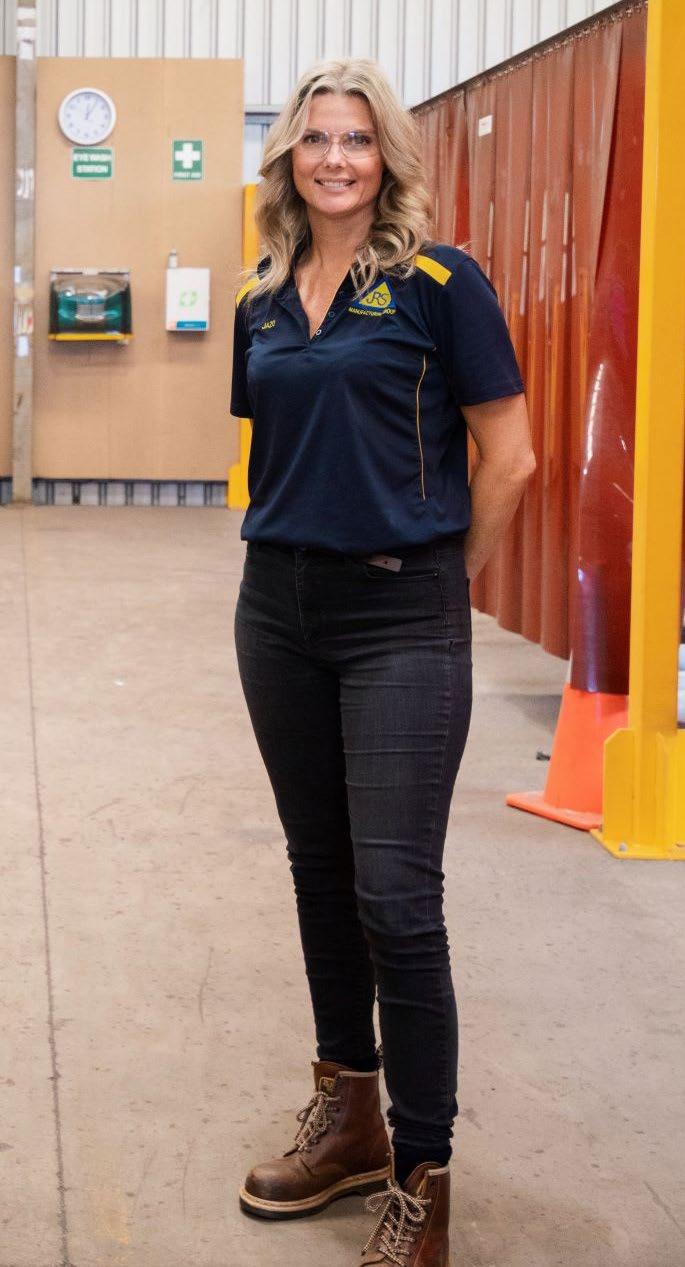
are training all the time once you commence.”
TAFE Queensland trainers deliver accredited courses on-site at the JRS Manufacturing Group facilities and liaise with JRS Supervisors’ throughout. As a result, students are more confident and comfortable— they have the opportunity to train in a familiar environment, using their own equipment.
“Ambitious individuals develop bestin-class skills in steel fabrication and welding, CNC machining and have exposure to the latest technology through specialised industrial and aerospace coatings and electroplating with additional focus on leadership, collaboration, design-led thinking and being able to communicate,” said Jasmine.
“These are all critical components if you’re going to be a leader and innovative in your trade. If you want to move forward beyond your trade certificate into other pathways, we want to see that human-centred approach to transformation.” An Incredible Future “Australian manufacturing has an incredible future ahead of it. There is an incredible opportunity here and we want to have the people in the industry that can do the job,” said Jasmine.
“Our business would fail if we didn’t invest in people and these opportunities. We wouldn’t be able to achieve our goals. We’d let our manufacturing partners down, which is a horrible outcome. And, more broadly, Australian manufacturing wouldn’t be able to achieve its desired outcomes, which would be tragic.”
Growing from a team of five to thirty over the last six years, the JRS team has diversified its product offerings from stand-alone manufacturing as boilermakers, to a hybrid manufacturing hub offering a multidisciplinary end-to-end production pipeline, using the latest technology.
The traditional manufacturing model is based on multiple skillsets across boiler making, welding, sandblasting, specialised surface coatings and finishing, CNC machining and logistics solutions, to deliver the final product to the customer. This requires various trades, across different industries and locations, to work cohesively to ensure customer timeframes and deliverables are met.
Identifying the opportunity to pivot to a multi-disciplinary manufacturing supplier, JRS Manufacturing Group is pioneering the workforce of the future and preparing to skill the workers to match.
The first intake of students is already delivering positive outcomes. “We have ten new apprentices that have signed on. They have come from outback Queensland. They’ve come from interstate. They’ve come from different lines of work—office jobs, beauty salons, abattoirs. We’ve had a really diverse range of individuals sign up and want to be a part of the Academy. They’ve connected really well and it’s fantastic to see the manner in which they’re picking up the skills. The excitement that they’re generating has already bled into our organisation more broadly—it
is thrilling to watch. We’re seeing the results of the mentorships we’ve built within the business and the mindset we’ve encouraged our staff and industry partners to take on. The first year of the Academy is going to be incredible—we’re going to have some great results.”
“This model is critical to the success and the future of the manufacturing industry. It is absolutely something I would share with any other business that is keen to take on that humancentred transformation around training,” said Jasmine.
Partnering with TAFE Queensland JRS has partnered with TAFE Queensland to launch the Skills Academy. JRS Skills Academy provides training and assessment of accredited qualifications on behalf of TAFE Queensland.
According to TAFE Queensland’s Manufacturing Faculty Director, Col Batzloff, “Throughout its 140 years, TAFE Queensland has demonstrated its agility in meeting emerging industry needs. The future is now and our partnership with such an innovative company ensures the evolution of traditional trades to meet the needs of a new generation. This is an exciting opportunity for everyone involved that will have real world impact.” Qualifications Available at the JRS Skills Academy
Boilermaker - Fabrication & Welding Assemble fabricated components, perform sheet and plate assembly, interpret technical drawings, and perform gas tungsten arc welding, manual metal arc welding, gas metal arc welding and welding to code standards. You will acquire industryspecific skills, as well as skills in planning, engineering measurement, interpreting technical drawings, and computer technology.
Mechanical - Fitting, Turning & CNC Theoretical and practical aspects of the manufacture, repair and replacement of engineering components for a variety of machinery. You will design and manufacture modifications and gain skills in the maintenance of plant and equipment. Develop the ability to work effectively and safely using specialist tools and equipment and execute CNC programming.
Aircraft Surface Finishing Trade Prepare the surfaces of aircraft and aircraft components for the application of surface finishes, apply paint, specialist finishes and decals or stencils. Also required for the application of aircraft registration markings, national markings and organisational logos.
Courses currently under development: Specialised Industrial Surface Preparation and Coating Application Skills and knowledge required to perform a wide range of surface preparation and protective coating application operations which occur across a range of typically heavy industry and infrastructure.
Electroplating and Specialised Chemical Finishing Skills and knowledge required to perform a wide range of surface preparations for both standard metals and composite materials. Understanding of chemical make up, testing and balancing, standards and systems utilised to support aviation, industrial and automotive applications.
About JRS Manufacturing
JRS Manufacturing Group is a Toowoombabased steel fabrication and welding company that specialises in fabrication consultation and construction of plate, pipe and structural steel products for clients in the civil, energy, mining, agricultural, oil and gas industries.
Established in 2014 with a small team of five people, the company originally rented a small shed and focused on boilermaking. In the years that followed, JRS grew quickly. The company expanded its service offering, quickly realising that in-house sandblasting and painting capabilities were needed to complement their fabrication services. In 2015, JRS purchased a separate paint shop, which increased their fabrication output. In 2019, with a strong future firmly on the horizon, JRS purchased a much larger workshop.
Today, the company boasts a workforce of more than 50 people and is looking to employ a lot more apprentices to handle the company’s expected future growth. Their services encompass pressure pipe fabrication and welding, abrasive blasting and coating, medium to heavy plate fabrication, specialised surface treatments, CNC and general machining and assembly.
The JRS Approach JRS guarantees to design, manufacture and deliver steel products that consistently meet unmatched quality standards. Their team ensures that any equipment and materials purchased are fit for their purpose, meet required safety standards and do not compromise on quality.
The JRS Manufacturing team adopts a twopronged approach to each trade skill within its Hybrid Manufacturing Hub.
All their team members are more like ‘skills architects’, carefully and deliberately applying design-based strategy with building-based execution.
This drives outcomes that deliver superior quality, collaborative innovation and long term manufacturing partnership success.
Further Information
For information, visit: jrsskillsacademy.com.au or jrsmanufacturinggroup.com.au
A CENTURY IN THE MAKING
Bradken’s 100 year history is founded on innovation, growth and the ability to overcome challenges
Building on 100 years of manufacturing and engineering expertise, Bradken is embracing continuous improvement and taking a new approach to support customers in adopting innovative solutions. Bradken specialises in the innovative design and manufacture of cast and fabricated iron and steel products for the mining and resources sector, as well as the rail and transit, energy, structural and industrial casting and defence markets. From small equipment pins to buckets, Bradken manufactures products from 500 grams to over 25 tonnes. Bradken today is a far cry from its humble beginnings in the 1920s, which were grounded in luck, some true entrepreneurial spirit and a dedicated commitment by its founders.
A Winning Bet What began with a lucky bet led to a bold new venture and the beginnings of Bradken.
In 1920, Leslie Bradford (General Manager) and Jim Kendall (Chief Mechanical Engineer)—two BHP steelworks employees—got lucky at the races one day and pledged their £15,000 winnings to start a steel foundry business. The horse they backed, ‘Jack Findlay’ completed a remarkable sequence of five wins during 1919 and 1920. With each win, Leslie Bradford, Jim Kendall and a group of friends rolled-over their bets. By January 1920, they had won a small fortune.
On 28 April 1920, the group used their winnings to establish the Alloy Steel Syndicate and build a steel foundry in Alexandria, Sydney to take advantage of what they saw as an untapped potential for industrial growth. Bradford Kendall Ltd was incorporated on 20 March 1922.
With its entrepreneurial spirit, and by meeting the needs of customers in more challenging markets, Bradken quickly established a name for itself in Australia and overseas.
In 1926, Bradford Kendall started to manufacture licensed products including railway couplers and undercarriages. This was a development that led to the first of many strategic business relationships, including a close affiliation with American Steel Foundries, which still exists today. It began supplying manganese steel products to the mining industry and eventually began manufacturing dredge buckets for the Malayan tin industry – one of the first steps in developing an export business.
Adapting and changing to markets through the Great Depression and


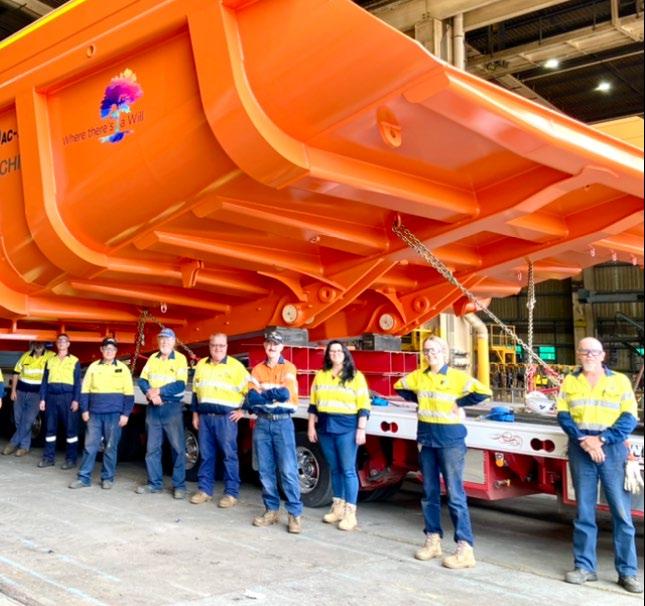
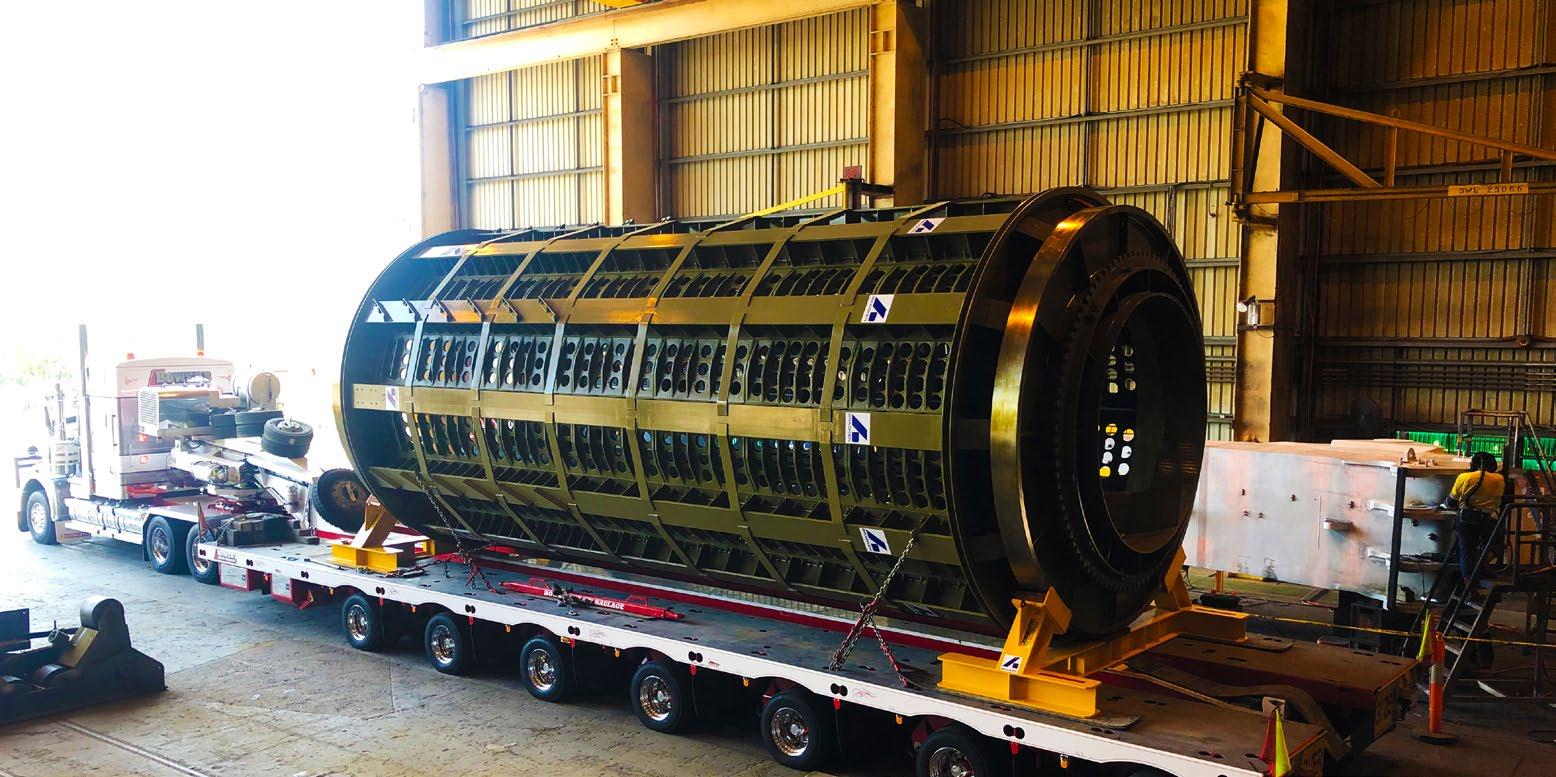
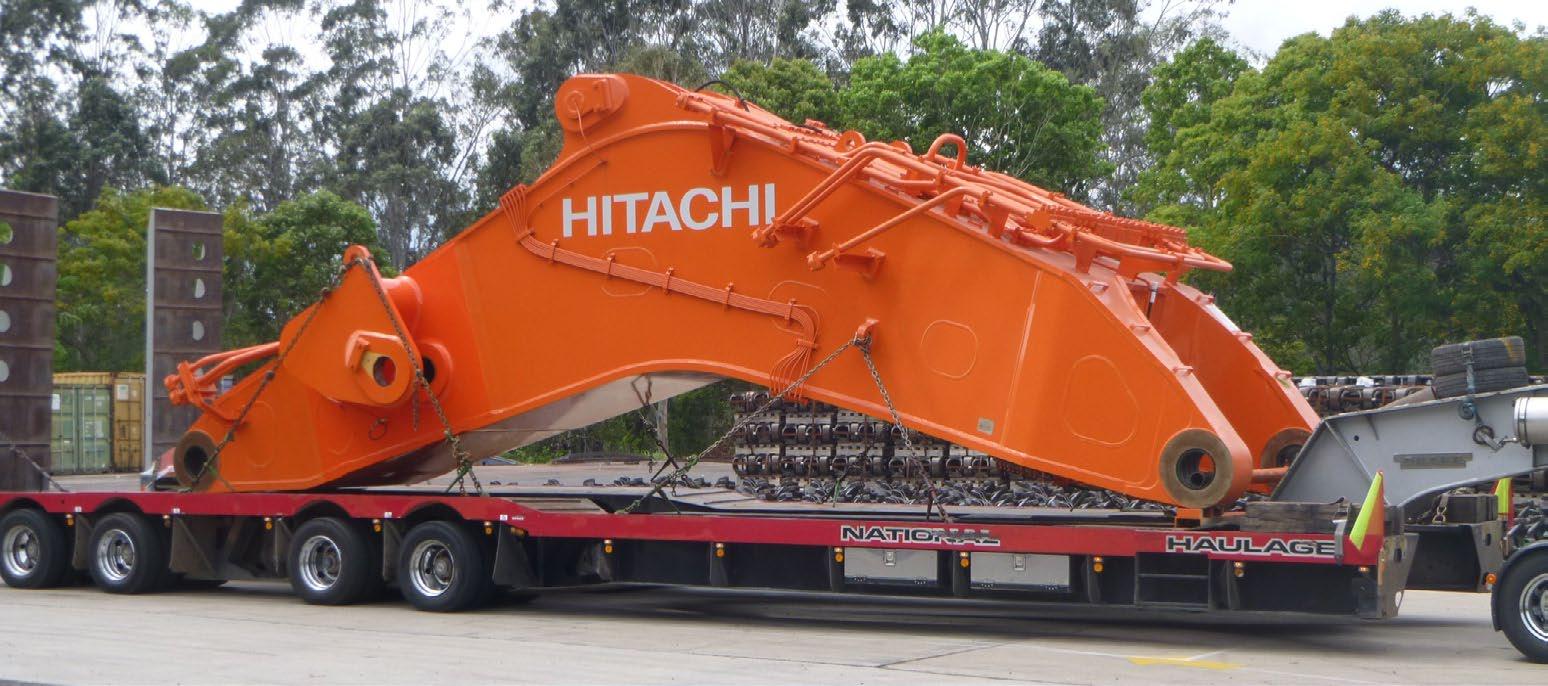
Photos (clockwise from top) Whatever part of the mining process you’re involved in, Bradken has you covered from pit to port, including Hitachi truck trays like that pictured.
HITACHI AC-3 EH5000 ULW tray manufactured and tested by Bradken’s Ipswich facilities—the only qualified OEM facility in Australia.
A 100% Bradken designed and manufactured coal rotary breaker barrel.
One of Bradken’s welders hard at work at their Ipswich facilities.
World War II, Bradken revealed its true character as a company and thrived. The company was engaged by the Federal Government to build cast armour for the Australian Built Tank Program. While it began by producing aerial bombs, naval gun parts and tank hulls, its biggest contribution to the war effort was the development of the world’s first onepiece cast tank hull in 1940.
After the war, Australia needed to rehabilitate its neglected railway systems and the introduction of diesel electric locomotives along with demand for higher speed and larger capacity freight trains were key forces behind Bradford Kendall’s growth. In 1948, the company took advantage of this boom and listed on the Sydney Stock Exchange.
During the 1950s, 60s and 70s, Bradford Kendall continued to expand its local operations, as well as build on its early export success.
Bradken is investing a recordsetting $68 million throughout the 2022 financial year in infrastructure upgrades and capacity expansion projects at its sites around the world.
Craig Lee (Executive General Manager Manufacturing, Bradken) said the program is part of Bradken’s broader innovation and sustainability strategy, to meet the challenges of our customers and to continue to be regarded as a leader for wear solutions in the global mining market well into the future.
“This year’s investment surpasses our previous record investment by more than 13% and includes funding for two key capacity expansion projects at our foundries, as well as more than 180 other smaller projects spread across our worldwide network of sites,” said Craig.
“Bradken has been part of the foundry industry since its beginning 100 years ago, and the truth is it’s an energy exhaustive industry - we need to do our part to reduce the greenhouse gas emissions produced by our manufacturing sites from electricity and fuel consumption.”
“Sustainability-focused improvement and site and equipment upgrade projects, like installing a dust extraction system and solar power at our site in Mt Thorley, Australia, a shakeout manipulator for reducing fugitive emissions in Coimbatore, India, and replacing the greens and extraction system at our foundry in Wodonga, Australia are just one way that we’re working towards an environmentally compliant and carbon neutral Bradken, and the establishment of a world class sustainability culture that will see us still operating well into our next 100 years.” In December 1974, the company officially changed its name to Bradken Consolidated Limited.

Over the years, the company has changed ownership several times. In the early 1980s, the Company was purchased by Australian National Industries, which was then purchased by Smorgon Steel Group in 1999, and then sold onto CHAMP in 2001. In 2004, Bradken listed on the Australian Stock Exchange and, in 2017, became a wholly owned subsidiary of Hitachi Construction Machinery Co. Limited, a member of the Hitachi Group, leading the company into a new era.
Durable, Reliable Solutions Over time, Bradken has found a calling in the mining industry in the design, engineering and manufacture of high-quality ground engaging tools, undercarriage systems, buckets and blades, along with mineral processing and fixed plant wear solutions.
With worldwide manufacturing, sales and distribution networks, Bradken supplies to the world’s major mining, industrial, rail, transport, defence, power and manufacturing companies. According to Bradken’s CEO, Sean Winstone, it is Bradken’s dedication to utilising the latest technology and innovations, whilst partnering with customers will drive change in the industry that has been the key to their success.
“Bradken is a business committed to the evolution of mining and resources, with its people at the forefront of innovation and technology,” Sean said. “To make it to 100 years, is quite a milestone for any company, and we’re very proud. A business and the individuals involved with it have to be resilient and innovative, as well as committed to strong values.”
“Throughout the years we have demonstrated and embraced the values at the heart of Bradken’s success, such as taking on challenges, seeing the customer in everything we do and working collaboratively to achieve goals both for our customers and the business. Matching our history of working with customers to understand what they need and value with technology solutions is key to Bradken’s future as we hone in on the mining and resources sector,” Sean said.
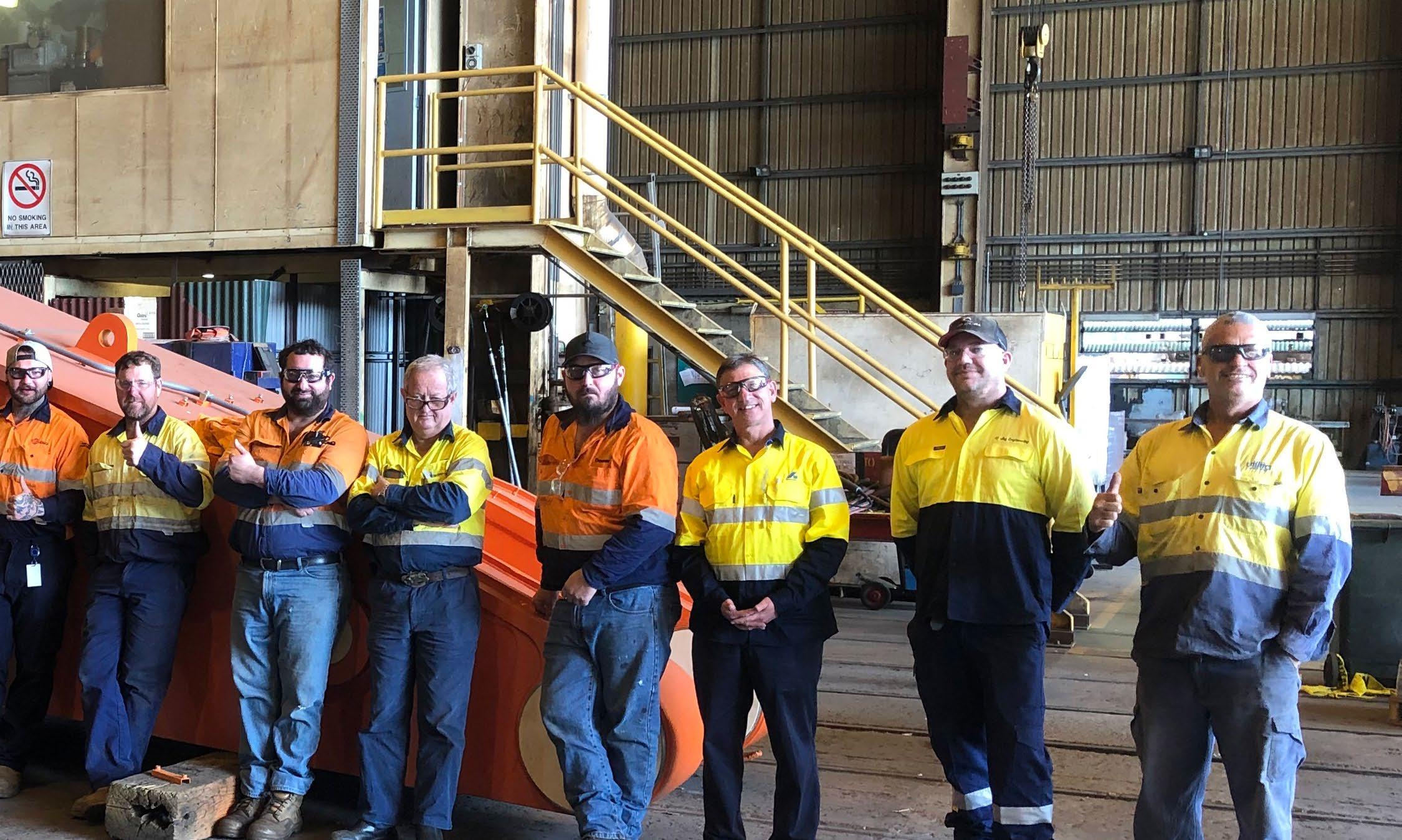
offer performance and condition monitoring, analysis and reporting for mineral processing and materials handling operations, along with mining machine wear products. Their solutions allow planned maintenance to be scheduled within production programs, improving site efficiency.
Bradken supplies customers with solutions that support their asset management processes, via secure wear monitoring and reporting systems.
Exceptional Welding Capabilities Bradken boasts exceptional welding capabilities. With long-term team members who hold various licences and inspection qualifications, Bradken’s welding is always completed to the highest quality standards.
Bradken’s Ipswich workshop is the only facility in Australia qualified by HITACHI Tokyo to undertake direct OEM welding and fabrication. In order to gain this qualification, Bradken’s facilities, capabilities and procedures underwent in-depth review by inspectors from Japan. direct OEM welding and fabrication ultrasonic testing. This also required confirmation from Japanese inspectors. Bradken’s inspector also holds a certification to ISO 9712 Level 2 for penetrant, magnetic particle and ultrasonic testing.
In addition, Bradken is certified to a variety of Australian Standards, primarily AS 1554 Parts 1, 2, 3, 4 and 5.
Building A Sustainable Future Bradken aims to be a good corporate citizen, investigating ways to reduce any adverse impacts of their operations. Bradken has committed to the goal of becoming carbon neutral and having netzero operational greenhouse gas emissions by 2030.
They’re already taking steps to minimise their environmental impact. Approximately 75% of Bradken’s energy is derived from renewable resources such as wind, solar and hydro. Plus, 98% of their mill liners are comprised of recycled materials and re-used liners.
Bradken also cares about their people, their safety and well-being, and the communities in which the company works. Bradken strives to make sure their workplace is a diverse and inclusive place to work. They maintain a focus on operating at an industry-leading quality, with excellent customer satisfaction, high productivity and good governance.
In support of workplace diversity, CEO Sean Winstone recently announced Bradken’s commitment of a $20,000 contribution to Newcastle University’s HunterWiSE STEM program. HunterWiSE is a partnership which supports women and girls in STEM careers and school subjects, nurturing the current and next generation of problem solvers in the local region.
“We look forward to what the future holds, and delivering innovative solutions that improve safety, sustainability, performance and productivity for our customers,” said Sean.
Further Information For further information about Bradken and their capabilities, visit: https://bradken.com
The Australian Cobotics Centre is working to improve the collaborative robotics capability within Australian manufacturing by training the next generation of manufacturing leaders, researchers, and technicians.
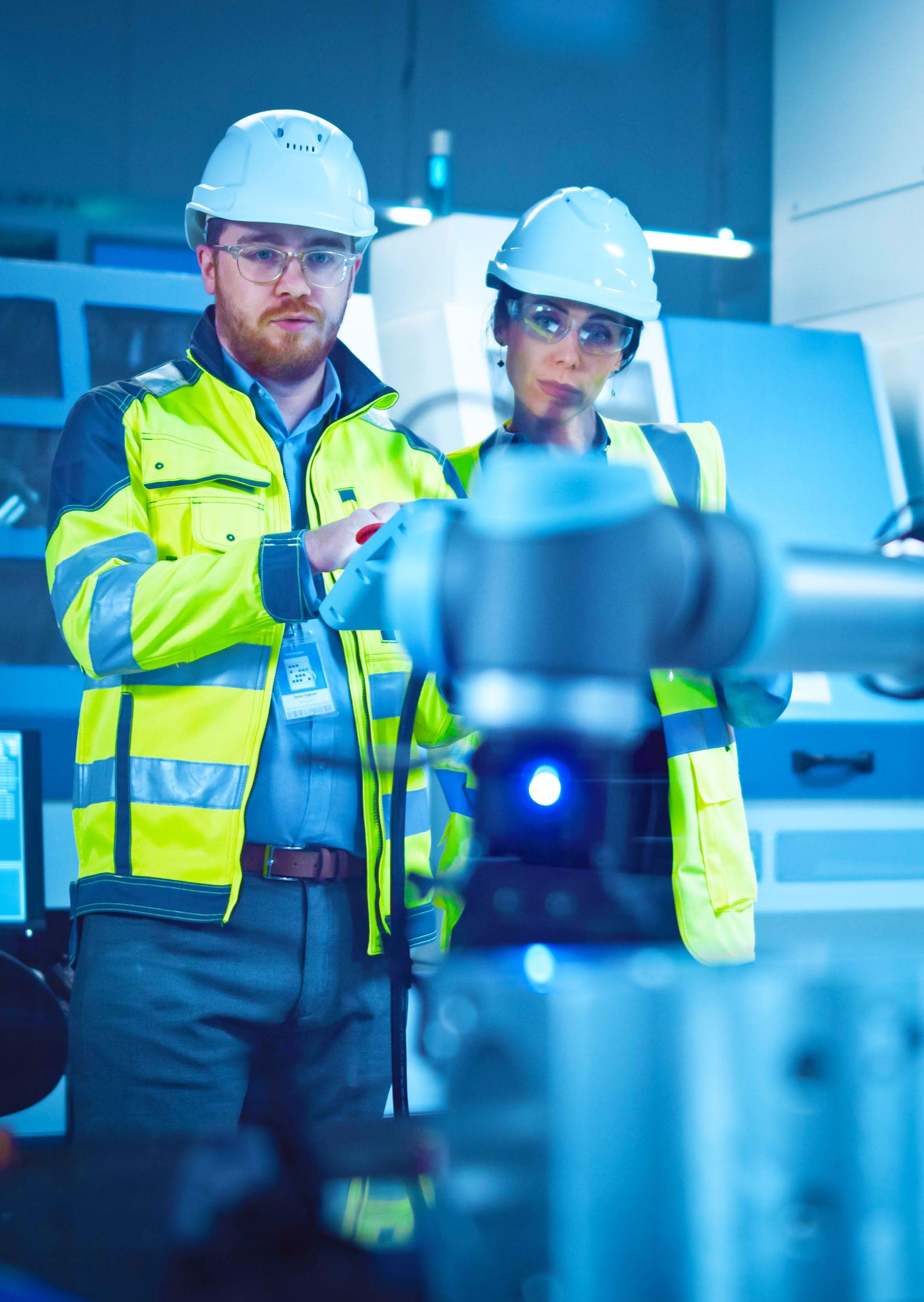
AUSTRALIAN COBOTICS CENTRE
Manufacturing in Australia is dominated by small to medium enterprises (SMEs). Many of these businesses are not in a position to adopt mass production manufacturing methods due to the small volumes and large variety of things they produce. Low-volume, high variability of product is considered a strength of these businesses as long as they can remain cost competitive. A combination of labour shortages, constantly improving health and safety considerations and the need for increasing efficiency of the manufacturing process are driving some of these SMEs to consider new ways of adopting collaborative robots (known as cobots).
The Australian Cobotics Centre is working to help SMEs adopt the use of cobotics. The Centre’s research programs address both the technological advances and the human and design factors that need to be considered when adopting collaborative robotics. Through this research and its implementation, the Centre will support manufacturers in creating a digitally-capable workforce of the future and a safer, more efficient and globally competitive Australian manufacturing industry.
According to Jonathan Roberts (Centre Director, Australian Cobotics Centre), “Our five research programs and their projects have been designed to maximise collaboration between industry partners and across the universities. The goal of the Biomimic Cobots Program is to allow collaborative robots to mimic humans in acquiring perception and awareness, learning, adaptation, and manipulation skills.”
“The Human-Robot Interaction Program addresses how humans are made aware of the movement and intentions of robotic systems, and will look at how to leverage multimodal interaction, including Augmented Reality and Virtual Reality, with robotic systems.”
“The aim of the Designing Socio Technical Robotic Systems Program is to embed holistic design as a critical factor in creating seamless integration of humans and machines working together to improve human work conditions and environments, and increase effectiveness and efficiencies in production, as well as workforce acceptance,” said Roberts.
“The Quality Assurance and Compliance Program will develop tools for the specification, capturing, monitoring and evaluation of such a digital thread in human-robot and robot-human collaboration scenarios.”
“The Human-Robot Workforce Program aims to answer research questions associated with: future skills and training needs; design and safety of jobs of the future;
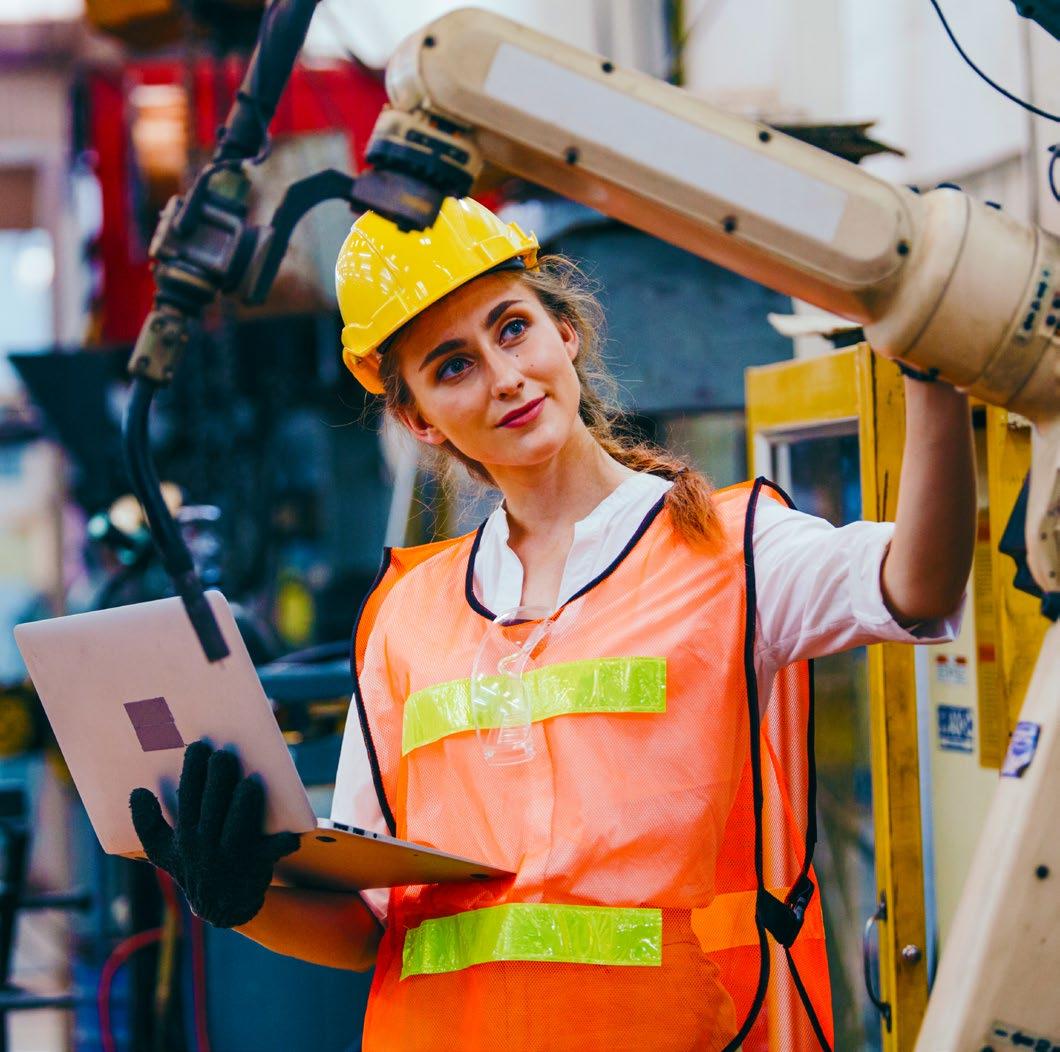
About the Australian Cobotics Centre
Opened in August 2021, the Australian Cobotics Centre is funded for five years as part of the Australian Research Council’s Industrial Transformation Research Program scheme. The Centre’s aim is to create a safer, more efficient and globally competitive manufacturing industry. The Centre’s objectives are to: improve the collaborative robotics capability within Australian manufacturing, and train researchers, engineers, technologists and manufacturing leaders with the skills and expertise needed to apply collaborative robotics technology. Headquartered at Queensland University of Technology (QUT), with two other locations at The University of Technology Sydney (UTS) and Swinburne University of Technology (SUT), the Centre is expected to build the human and technical capability needed to underpin Australia’s global competitiveness in advanced manufacturing.

ARM Hub’s Mechatronics Engineer, Amelia Luu, and MetalTech Industries ‘ lead welder program the cobot.
managing workplace readiness for the successful implementation of collaborative robotics; and the benefits of greater workforce diversity and longevity,” said Roberts.
“We’ve already completed a number of site visits to businesses and Weld Australia members who are interested in exploring the use of cobots in welding. These businesses stepped us through their existing operations, and we ran them through what other companies have implemented in terms of cobotics. What is clear from these site visits is that there are ample opportunities for cobots to make businesses more efficient and improve the conditions of staff undertaking welding. We can potentially make welders’ job easier and better with cobots.” Case Study: MetalTech Industries Developing shop-floor capability of SMEs to adopt technology is essential for the growth of advanced manufacturing within Australia. The Cobotic Centre’s industry partner, the ARM Hub recently worked with MetalTech Industries in Wacol to achieve just this.
ARM Hub’s Mechatronics Engineer, Amelia Luu, worked alongside MetalTech Industries’ lead welder to improve their jig design and co-bot program.
By working together they were able to augment his welding expertise with her knowledge of collaborative robot programming to trouble-shoot solutions and successfully perform small batch TIG welding of brackets – a task that was previously unable to be fulfilled.
Although cobotic welding systems are commercially available and are increasingly in demand to address skills shortages, the user interfaces and variable support services postcommissioning, can be problematic for new users and traditional manufacturers – particularly when compared to the traditional machining systems (like CNC cutters and benders) that manufacturers are used to.
With the support of ARM Hub, MetalTech Industries’ adoption of advanced technology will enable digital capability growth, skills expansion and increased production.
Industry Assistance Package Weld Australia is offering its members the opportunity to become Secondary Partners under the Weld Australia umbrella.
According to Geoff Crittenden (CEO, Weld Australia), “Together, the Australian Cobotics Centre and Weld Australia are offering practical solutions to industry that flow from the research undertaken at the Australian Cobotics Centre. By participating in the program, companies can expect benefits like access to subsidised advanced manufacturing technology designed to solve specific manufacturing problems, enhanced productivity, increased safety, and minimised employee turnover.”
Secondary Partners have the opportunity to jointly develop a specific project that provides value to their organisation without having to fund the associated research and development costs. It also provides access to workforce training and development to enable the implementation of cobotic and associated technologies.
As a Secondary Partner, you will receive: • A planning workshop delivered by the
Australian Cobotics Centre team to identify the project scope, outcomes and milestones • A resulting proposal that outlines the project and any subsequent ‘translation’ projects that may be implemented • A proposal that shows how the research applies to your project
Funding provided by the Secondary Partner will cover costs associated with equipment for prototyping solutions, the PhD scholarship of the student working with the organisation, and site visits. The Secondary Partner will also be responsible for directly procuring any equipment that might be required for the final solution.
There is also a range of other associated benefits, including: access to a network of industry partners with which to share experiences and resources that drive value-delivering technological and workforce changes; linkages to a network of suppliers who can assist with automation; and access to worldclass research and infrastructure and facilities.
Further Information
For further information, or to become a Secondary Partner, contact Geoff Crittenden (CEO, Weld Australia) via email: ceo@weldaustralia.com.au Open Innovation Network
One of the most unique features of the Australian Cobotics Centre is its open innovation practices.
“Open innovation is a distributed innovation process based on purposively managed knowledge flows across organisational boundaries, using pecuniary and nonpecuniary mechanisms in line with each organisation’s business model.”
This Open Innovation Network is key in supporting the Centre’s to increase the collaborative robotics capability and train researchers and industry, both within the Centre and beyond. The group: • Brokers peer-to-peer collaboration and business knowledge transfer between Partner Organisations arising from Centre programs and outcomes • Delivers industry-focused workshops for Centre students, researchers and Partner Investigators to explore wider industry application • Offers demonstration events and workshops for
Partner Organisations and manufacturing industry stakeholders to showcase Centre outcomes
For more information, visit: australiancobotics.org/open-innovation-network

COBOTICS SURVEY RESULTS
Advanced technology, production challenges, and critical job roles
The Australian Cobotics Centre conducted a survey of Weld Australia members in January and February 2022. The survey focused on cobotics knowledge, interests and requirements, as well as the workforce and technology challenges being faced by industry. 41 responses were received from all over Australia, with the majority of respondents located in Queensland and Victoria. Most survey respondents indicated that they operate in the manufacturing, mining, oil and gas, or power generation sector.
Advanced Technology When asked about their use of advanced technology, 39% of respondents indicated that they do not have advanced technologies in their workplace. Nine had robots, two had cobots, five used virtual reality, and five used augmented reality. One stated that they use automated welding and forming, and one uses straight line welding gantries and track welders.
When it came to implementing advanced technology, the survey revealed a range of attitudes. 14% of respondents said their organisation had not considered implementing robotic or cobotic technology, while another 12% were undecided on its implementation. 7% had previously tried integrating advanced technology in their operations, but were unsatisfied with the results. Another 21% would like to implement cobots but either had barriers, or didn’t know where to use them.
Fifteen respondents did not have any relationships with engineering firms to assist in implementing new production methods. A further two had previous, but not current, relationships with engineering firms. Fourteen had current ongoing relationships with engineering firms or were engineering firms.

Production Challenges Respondents were asked to indicate their most difficult production challenges. 56% of respondents indicated that efficiency was a challenge, and 48% indicated that quality control was a challenge. Other common challenges included supply chain issues and worker safety.
Respondents identified several ergonomically or environmentally challenging tasks that may be a target for cobots to assist workers, including: • Grinding • Overhead welding • Polishing • Cutting • Material handling and processing • Repetitive manual handling • Heavy lifting • Radiography weld inspections
Critical Job Roles Organisations were asked to identify challenges associated with attraction, retention, training, diversity, and health and safety. The key challenge was identified as finding and recruiting skilled workers.
Training staff in new skills and processes and maintaining accuracy


in jobs subject to human error were also identified as major challenges.
A wide range of critical job roles were identified, with welding highlighted as the most critical. Other critical roles included project managers, supervisors, and staff with knowledge of welding and health and safety standards.
Implementing New Technology When asked to indicate the relative importance of factors when implementing new technology, 34% of respondents stated that the design and setup of the workshop is very important. Training staff in new skills, and the cost of the technology were also identified as very important. Addressing employee concerns related to operating new technology, safety, quality and job security was also identified as critical to implementation.
The Australian Cobotics Centre’s research programs take a holistic approach to managing these challenges by addressing the design and human factors that arise when Cobotics are introduced to the workplace. The research programs aim to improve collaborative robotics capability within Australian manufacturing in ways that also help to attract, retain and develop workers for the future of manufacturing.
Source: Laundon, M., Williams, P. and Hearn, G. (2022) Australian Cobotics Centre Survey of Weld Australia Members Summary Report, Queensland University of Technology and Australian Cobotics Centre.
Further Information If you’d like further details, or are keen to get involved in the Australian Cobotics Centre visit: australiancobotics.org The Benefits of Cobots
Cobots are specifically designed to share the work space with human beings, making automation easier for businesses of all sizes, particularly SMEs. Cobots are generally versatile, lightweight, require relatively little space, and are much easier to program than their industrial counterparts. They can also capture large volumes of data that can be deployed in areas such as predictive maintenance.
Improved Productivity and Profitability Robots and cobots play an essential role in creating lean manufacturing processes, helping reduce or eliminate redundancies, errors, bottlenecks and waste. The right type of technology can help eliminate workflow delays and duplications and accelerate entire processes through the automation of individual tasks.
Superior Quality and Repeatability The integration of cobots into production processes is proven to deliver superior quality outcomes and higher repeatability. Any process that improves weld quality and repeatability is worthwhile. Welding is not just a commodity, or a simple, straightforward process. When welds fail, the results can be disastrous. A poor quality weld can be hugely expensive, and can cause massive damage, injuries, and even fatalities.
Growth in Domestic and Export Markets With increased productivity, quality and repeatability, manufacturers are able to leverage new domestic and export markets. Increases in productivity enable manufactures to deliver on changing customer needs and mass customisation, while maintaining a sustainable competitive advantage.
Safer Working Conditions The use of robots and cobots has the power to improve safety for welders and manufacturing workers. As automation reduces routine, dangerous manual work, workplace injuries are expected to drop by as much as 11%. For instance, the use of robots and co-bots (particularly in confined spaces) helps to remove welders from immediate exposure to welding fumes, ultraviolent radiation, heat and sparks.
Greater Job Satisfaction A move towards the use of robots and cobots will unburden the average Australian of two hours of the most tedious and manual work each week. Approximately 62% of low-skilled workers will experience improved job satisfaction, and wages for non-automatable work will increase by around 20%. Introduction of cobots into production lines allow businesses to make better use of human skill and innovation, with machines taking over mundane tasks so that employees can focus on critical thinking, quality and creativity.










